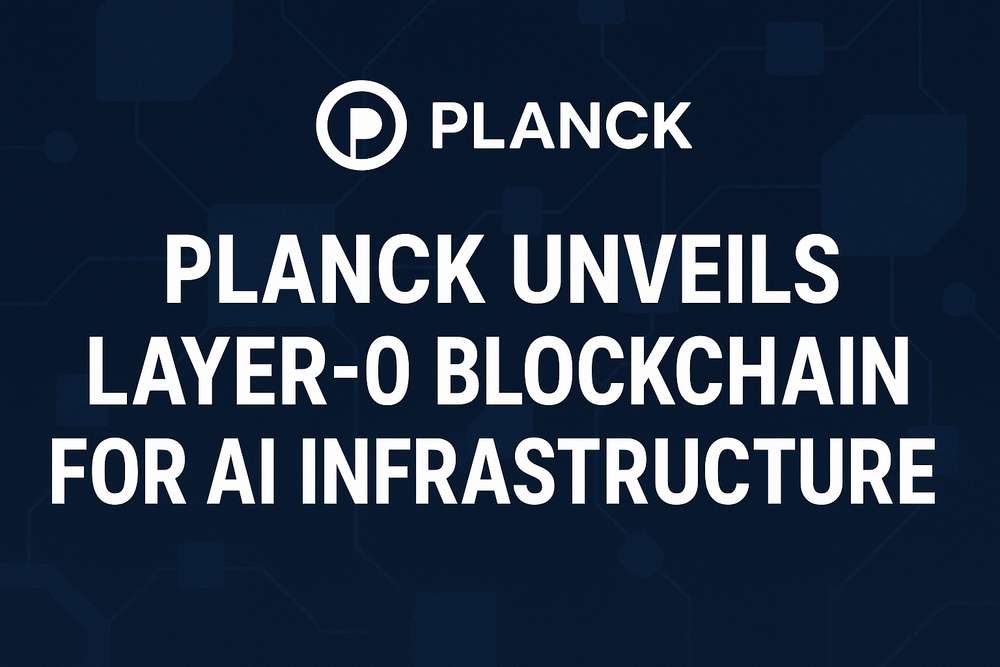Planck Community has formally launched its layer-0 blockchain designed to energy decentralized synthetic intelligence infrastructure, marking a major milestone within the convergence of blockchain and AI applied sciences. The protocol goals to offer scalable, sovereign AI techniques and decentralized infrastructure protocols (DePIN) via its modular structure. Introduced on July 30, 2025, this launch follows months of growth and strategic partnerships with main tech corporations and traders.
The platform combines a GPU-native layer-1 chain with bare-metal compute assets, enabling builders to deploy AI fashions and infrastructure primitives at unprecedented value effectivity. Planck’s ecosystem contains tokenized compute entry, co-staking mechanisms, and enterprise-grade GPU assets deployed throughout top-tier knowledge facilities. Early traction reveals $1.4 million in income from GPU rental and cloud computing providers year-to-date.
Planck’s roadmap contains the upcoming launch of Planck₀ by the tip of 2025 and Planck₁ two months after its token era occasion (TGE). These phases will introduce co-staking performance, onboarding of sovereign AI layer-1 chains, and enterprise entry to superior AI infrastructure.
Planck Community’s Imaginative and prescient for Decentralized AI Infrastructure
Planck positions itself because the “decentralized AI infrastructure stack of Web3”, addressing important gaps in current cloud and blockchain ecosystems. Its modular layer-0 protocol coordinates compute, safety, and messaging for AI purposes, whereas the GPU-native layer-1 chain permits direct integration of AI workloads. This structure permits builders to coach, deploy, and orchestrate fashions natively on-chain, bypassing centralized cloud suppliers.
The mission emphasizes sovereign AI techniques, enabling organizations to take care of management over their knowledge and fashions. By tokenizing compute assets, Planck introduces a brand new financial mannequin the place customers can stake tokens ($PLANCK) to entry GPU energy with out proudly owning {hardware}. This strategy contrasts with conventional cloud suppliers like AWS or Google Cloud, which require upfront infrastructure investments.
Key Buyers and Strategic Companions
Planck has secured backing from outstanding traders and establishments, together with DNA Fund (led by Brock Pierce and Scott Walker), GDA Capital, and DePIN X Capital. Extra assist comes from Arcanum Ventures, Nexus Fusion Capital, and over 25 angel traders.
Technical validation is clear via grants from Microsoft, AWS, Nvidia, and Google, underscoring Planck’s position as a bridge between conventional tech giants and decentralized ecosystems. These partnerships present entry to enterprise-grade infrastructure and AI experience, reinforcing Planck’s credibility within the AI-blockchain house.
Technical Improvements and Roadmap
Planck’s infrastructure contains $60 million+ deployed in top-tier knowledge facilities, providing GPU assets at a fraction of conventional cloud prices. The platform’s modular AI infrastructure stack helps end-to-end AI growth, from mannequin coaching to deployment, with built-in toolsets for orchestration.
Key upcoming milestones embody:
- Planck₀ launch by finish of 2025
- Planck₁ launch two months post-TGE
- Onboarding of sovereign AI L1s and DePIN chains
- Co-staking performance for token holders
- Enterprise entry to AI infrastructure
Co-staking will permit $PLANCK token holders to earn rewards alongside GPU operators, making a decentralized community of compute suppliers. This mannequin incentivizes participation whereas making certain useful resource availability for AI workloads.
Planck’s tokenized compute mannequin eliminates {hardware} possession obstacles, enabling builders to entry high-performance GPUs via staking. This strategy might disrupt conventional cloud economics, the place suppliers like AWS dominate with centralized infrastructure.
Enterprise adoption is a key focus, with Planck providing cost-efficient entry to AI infrastructure. The platform’s integration with main AI frameworks and instruments positions it as a important layer for constructing decentralized AI purposes.
Planck’s workforce contains veterans from Google Cloud, Nvidia, Coinbase, and Polkadot, making certain technical depth throughout blockchain and AI domains. This experience is mirrored within the platform’s design, which balances scalability with safety.
Be taught extra about Planck’s technical structure in its whitepaper or go to the official website for updates.
Set up Coin Push cellular app to get worthwhile crypto alerts. Coin Push sends well timed notifications – so that you don’t miss any main market actions.
Market Affect and Future Outlook
Planck’s launch might redefine how AI infrastructure is constructed and accessed, significantly in decentralized ecosystems. By offering GPU assets at decrease prices than conventional clouds, the platform could appeal to builders constructing AI purposes in DeFi, autonomous brokers, and decentralized knowledge networks. Nevertheless, competitors from established cloud suppliers and rising blockchain-AI tasks will take a look at Planck’s adoption charges.
The success of Planck’s tokenized compute mannequin hinges on community results and GPU operator participation. If co-staking incentives align with market demand, Planck might turn into a important infrastructure layer for Web3 AI. Conversely, regulatory challenges round decentralized compute and tokenized assets could pose hurdles.
- Layer-0 Blockchain
- A foundational protocol that permits interoperability and coordination between a number of blockchain networks, typically dealing with cross-chain transactions and safety.
- Tokenized Compute
- A mannequin the place computational assets (e.g., GPU energy) are represented as tokens, permitting customers to entry infrastructure with out proudly owning {hardware}.
- Co-Staking
- A mechanism the place token holders and infrastructure suppliers collectively stake property to safe a community, sharing rewards proportionally.
- DePIN
- Decentralized Finance and Infrastructure Protocols, referring to blockchain-based techniques that change centralized intermediaries in monetary and infrastructure providers.
